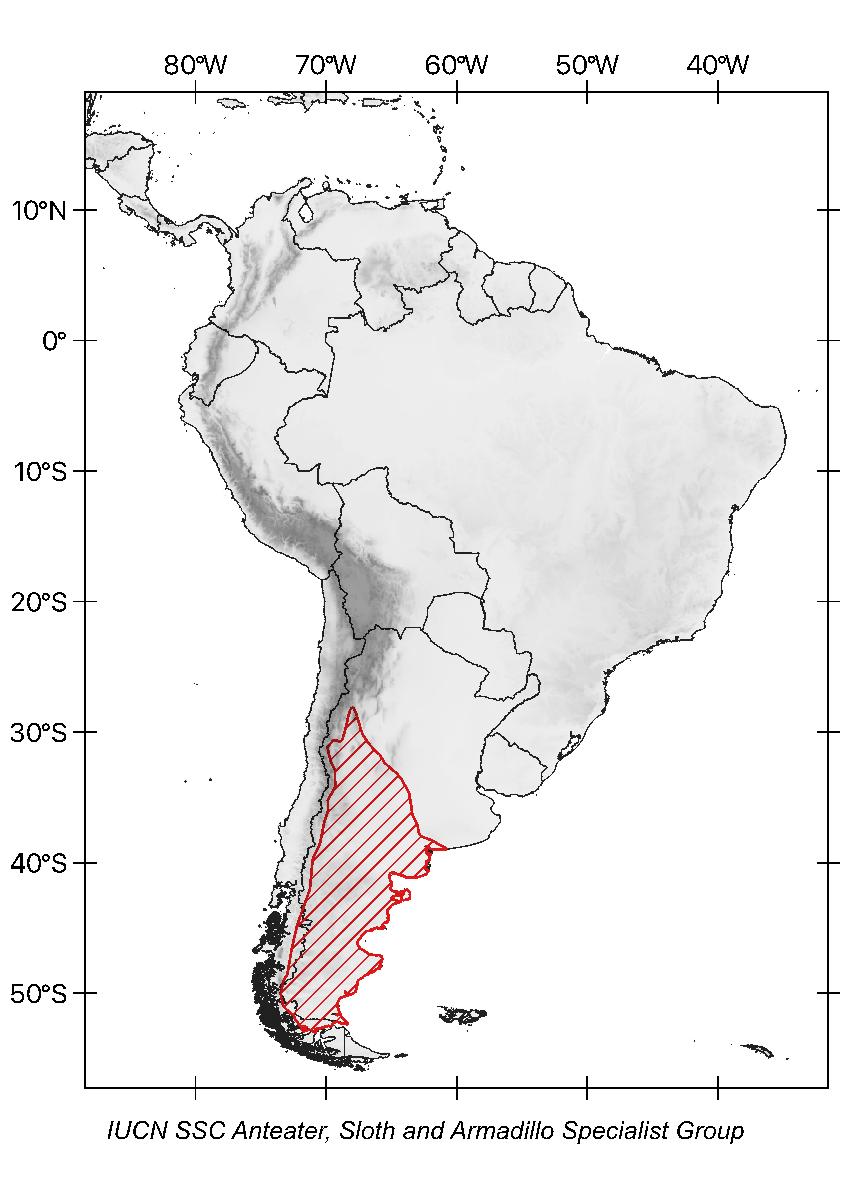Pichi
(Zaedyus pichiy)
other common names
Dwarf armadillo
Taxonomy
Order: Cingulata
Family: Chlamyphoridae
Subfamily: Euphractinae


description
This small armadillo has a head-body length of 22–31 cm, a tail of 8–13 cm length, and proportionally short ears that are approximately 1.5 cm long. It weighs around 0.7–1.5 kg. The carapace color varies from light yellow to almost black, with a lighter strip of varying length and width on the dorsum. There are 6–8 movable bands, and relatively long hair protrude through the scales. The scutes on the carapace border are sharply pointed.

range
The pichi ranges from Argentina (San Juan and La Rioja) and eastern Chile south to the Straits of Magellan. Its exact distribution in Chile is uncertain. It is found from sea level to 2,500 m asl.

HaBITAT and ECOLOGy
Zaedyus pichiy can be found in arid to semi-arid habitats with firm, sandy soils. The species occurs in the natural grasslands of the Patagonian steppe and the Pampas, as well as in the shrublands of the Chacoan monte. It may also be found in degraded habitat, such as pastureland and plantations.
This solitary species is mainly active during the day. It hibernates in winter and can enter shallow daily torpor during the rest of the year, especially during periods of environmental stress. Burrows can reach several meters length and be as deep as 1.5 m. They are sealed while being excavated, both for temperature control and to prevent access of predators.
It is not possible to determine their age once they reach adult size, and long-term population studies on pichis are lacking. Therefore, there are no data on the longevity, survival rates, or reproductive rates of wild pichis. Data from captive animals in Argentina show that females reach sexual maturity at 9-10 months of age, but that some females do not breed until their second year. Limited data from captive pichis suggest that their longevity is approximately 10 years. The generation length is thus suspected to be around 4 years.

diet
Pichis are opportunistic omnivores with a preference for insects. They feed on beetles and their larvae, a variety of ant species, plant material, scorpions, spiders, other insects, soil-nesting bees, vertebrates such as lizards and small mammals, and fungi.

reproduction
Pichis mate in spring to early summer, and they are probably induced ovulators. Several males can chase a female, forming mating trains. After a gestation period of 60 days, 1–2, rarely 3, offspring are born inside the burrow, where they remain during the entire lactation period of approximately 40 days.

curious facts
The pichi is the only xenarthran known to hibernate. During winter, its body temperature can drop as low as 14.5 °C.

threats
Zaedyus pichiy is threatened by hunting for food and sport, including hunting with dogs. It is the main prey of poachers in Mendoza Province, Argentina. An epidemic of an unknown disease has locally affected the species in some areas, and appears to be associated with rainy periods. It is threatened to some degree by overgrazing of its habitat by cattle.
The species is also affected by vehicle collisions and the increasing frequency of wildfires. It is threatened by the conversion and degradation of its habitat due to agricultural and livestock activities. The presence of coniferous plantations in northern Patagonia significantly reduces the occurrence and the availability of food for this armadillo. Additionally, it is threatened to some degree by overgrazing of its habitat by cattle.

Population trend

conservation status
Zaedyus pichiy is listed as Near Threatened as, although widespread and present in a number of protected areas, it is hunted significantly, especially in northern and eastern portions of its range, with local extinctions recorded in some areas; there is little known about the declines in the southern part of its range. It is thought likely that this species almost qualifies for a threatened category under criterion A2d due to ongoing exploitation levels, habitat loss, wildfires, and vehicle collisions, which have led to a decline in the order of 25% over three generations (suspected to be around 12 years).